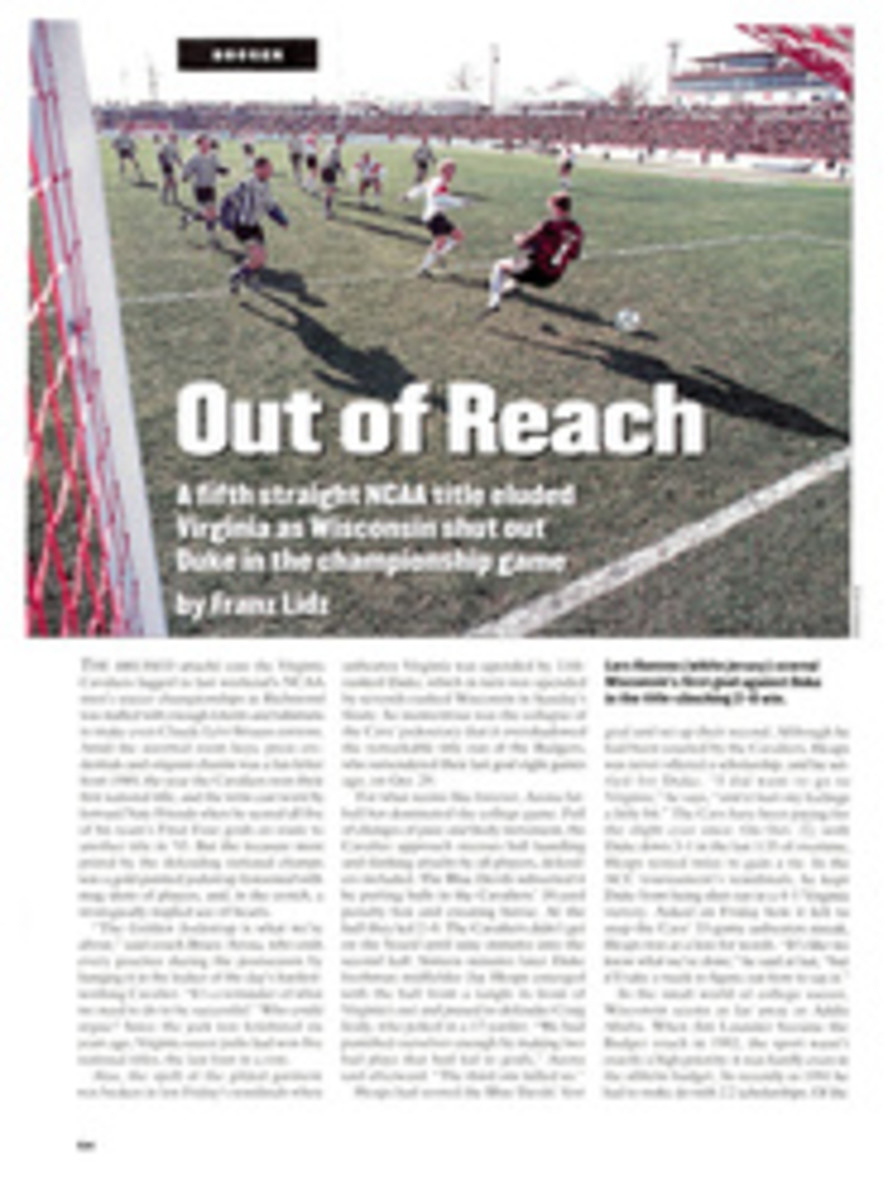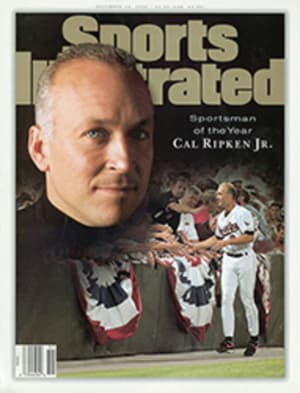
King No More
"Where you fellas from?" the taxi driver asked his passengers
with typical Denver howdy-neighbor friendliness.
"Montreal."
"Say, we got a new goalie from there. Know anything about him?"
"Well," said the new goalie himself, "I hope he's a good guy."
Patrick Roy is a good guy. He's high maintenance—exacting, combative, sensitive—but a good guy. Of course, he is an even better goalie. In his 10 years with the Montreal Canadiens, he was a three-time first-team All-Star, a two-time playoff MVP and a one-man franchise. That's why it makes almost zero sense that Roy, even after an ugly public showdown with rookie Canadien coach Mario Tremblay during a game on Dec. 2 against the Detroit Red Wings, is now stopping pucks in a city where cabbies don't know his face and no one can pronounce his name.
Roy—that's Rwah, as in King Louis XIV, not Roy as in Rogers—was traded to the Colorado Avalanche on Dec. 6 with Montreal captain Mike Keane for promising 20-year-old goalie Jocelyn Thibault and wingers Andrei Kovalenko and Martin Rucinsky. It was the most stunning hockey deal since the Edmonton Oilers shipped Wayne Gretzky to the Los Angeles Kings in 1988. Roy's trade was no more a '50s-style talent swap than Gretzky's, which makes the question of who won this trade—answer: Colorado—practically irrelevant.
The Roy trade raised a more profound, '90s question about whether special players deserve special treatment, whether a star system that puts athletes' names up in neon-Deion lights should prevail over the hoary high school notion that there's no I in team. They can argue the following point in NHL front offices and at the Harvard Business School: Did Roy's team-high $2.8 million salary and his immense marketability in Montreal make him almost as much a partner of the Canadiens' owners as an employee? Hasn't Gretzky, who put millions in the Kings' coffers, earned a say in Los Angeles's personnel matters? When New York Ranger captain Mark Messier had a falling-out with coach Roger Neilson in 1993, who was deemed to be more vital to the team?
Canadien president Ronald Corey and new Montreal general manager Rejean Houle made sure Roy was not a coach killer by backing Tremblay, a former Canadien wing who was Roy's roommate when Roy was a rookie. Earlier in his career Roy also occasionally had bumped hard heads with coach Pat Burns. Burns, who now guides the Toronto Maple Leafs, recalls one "Screw you ... No, screw you" shouting match with Roy, although they usually got along. But Roy seemed happiest as coach-without-portfolio under Tremblay's predecessor, Jacques Demers, who let Roy set his own schedule and all but kissed his most important asset.
"There are certain athletes, like Patrick, who are purebreds," says Demers, who was fired four games into this season and now scouts for the Canadiens. "They're intense. Winners. Guys I've coached like Steve Yzerman in Detroit and Mike Liut, Bernie Federko and Doug Gilmour in St. Louis. They're not always easy to deal with. I was around [Piston coach] Chuck Daly, and I saw him praise Isiah Thomas, and, well, maybe there's a little different attitude in the States about how you treat stars. Patrick was the best player in Montreal since Guy Lafleur, and your best athletes—not your fourth-liners—win Stanley Cups for you. Roy is a guy who won 10 straight overtime games to get us the Cup in 1993. Maybe Patrick would say something in the dressing room that guys didn't like"—Roy fought teammate Mathieu Schneider in the dressing room between periods of a game last season—"but I'd tell them to let it go. Patrick was also the guy who was going to come back and win the game for us."
Tremblay, 39, is not a warm and fuzzy coach; he's a product of the late '70s, when he was a Canadien third-liner for the hard-driving Scott Bowman. Less than a week before his blowup with Roy, Tremblay told reporters how much he had chafed under Bowman. The irony is, when challenged by Roy in a game against Bowman's Red Wings, Tremblay responded exactly as Bowman might have.
The showdown came at the Montreal Forum—St. Patrick's cathedral. Detroit, which had taken a 5-1 first-period lead, pumped two more past Roy in the first five minutes of the second. When the crowd offered a sarcastic huzzah after Roy's next save, Roy raised his arms in a mocking way. As far as Tremblay was concerned, Roy had just thrown himself on the ice, pounded his fists, kicked his feet and demanded a pony. If Tremblay had any thoughts of sparing Roy further embarrassment, as hockey coaches typically do with a goalie who's getting shelled, they vanished. Show me up? I'll show you up. Tremblay, who would later feebly explain that he thought Montreal was still in the game, didn't lift Roy until the score was 9-1 with eight minutes left in the second period.
When Roy skated off, he removed his mask and walked past Tremblay toward the backup goalie's stool at the far end of the bench. Tremblay glared. Roy glared. If looks could kill, there would have been a double murder. Roy then wheeled, locked eyeballs with Tremblay again and walked past him to Corey, who was sitting behind the bench in the traditional, and intrusive, section 105 seat of Canadien bosses. "This is my last game for Montreal," Roy told Corey. Roy then stomped back to the stool, turned to Tremblay and said, "T'as compris, 'stie [Did'ya understand, dammit]?" Roy and Tremblay had a screaming match in the dressing room after the period. The next day the Canadiens announced that Roy had been suspended and would be traded.
"I was brought up on the Montreal Canadiens with big stars like Jean Beliveau, Henri Richard, Yvan Cournoyer, Bob Gainey, Guy Lafleur, Ken Dryden, The Big Three [defensemen Larry Robinson, Serge Savard and Guy Lapointe], and never once did I feel those guys asked for or got special treatment," Houle says. "Nobody's more important than the team."
The Canadiens' announcement touched off a dizzying series of press conferences, including one the next day by a tearful Roy that was covered live by Newsworld, Canada's version of CNN, testimony to his import even beyond Montreal. But through the blizzard of sound bites, apologies, denials and metaphorical turning of pages, something was wrong. Why was there no effort at reconciliation? Roy's agent, Bob Sauve, and Tremblay both made vague references to earlier "incidents"—as a broadcaster, Tremblay sometimes had been critical of Roy—although no one would say just what those incidents had been or when they had happened. There was one theory that Roy's tantrum had been premeditated, his ticket out of a province that simply cared too much about hockey. "No," Roy says. "I was so close to Jacques Plante [23 wins from breaking Plante's team record]. Who wouldn't want to go down in Canadien goaltending history?"
There was another theory that the Montreal front office had pounced on Roy's gaffe as an excuse to trade a 30-year-old whose skills had begun to slip, but the Canadiens will move to the new 21,000-seat Forum on March 16, and Corey wants to put a classy team in it. The post-Roy Canadiens are simply not that good, at least for now, so this scenario seems just as dubious.
On Dec. 6, when Houle completed the trade with Colorado general manager Pierre Lacroix, Roy's former agent and close friend, the mood in Montreal was as sour as the aftertaste left by some of the lemons the Canadiens have drafted since getting Roy with the 51st pick in 1984. The consensus: History will judge Roy a better goalie than Tremblay a coach, and Tremblay, wildly popular after becoming coach and turning around an 0-5 team, will be seen as the snake who drove Roy out of Montreal. "It's totally explainable that Patrick Roy was humiliated and frustrated being left out there in a 7-1 game. What's unexplainable is Mario's reasoning," says Mike Bossy, the Hall of Fame right wing who works for Montreal radio station CKOI. "Mario might not have experience as a coach, but he had 30 years' experience in hockey. I can't accept that a rookie coach could get rid of the best goalie in the NHL after 19 games."
While the deal was another step in remaking the Canadiens—only four members of the 1993 Stanley Cup champions remain, and three captains have been traded in the past 16 months—for the Avalanche, it made them the team to beat in the Western
Conference. Lacroix has had a better fall than Jay Leno. The talented Quebec Nordiques, the previous incarnation of the Avalanche, were blown out in the first round of the playoffs last spring by the Rangers because they lacked playoff experience, a power-play quarterback and an experienced goalie. Since October, Lacroix has pried loose playoff MVP Claude Lemieux from the New Jersey Devils, scoring defenseman Sandis Ozolinsh from the San Jose Sharks and Roy. The Avalanche are now the NHL's glamour team, which even corporate ticket holders eventually should figure out. When Roy made his Colorado debut last Thursday in a 5-3 loss to Edmonton, 1,000 seats in the lower bowl of sold-out McNichols Arena were empty, even though the Avalanche had just acquired a goaltending god. The ovation Thibault received at the Forum simply for skating across the ice to do a between-periods interview the previous night was more lusty than anything Roy heard in his Colorado debut. Now maybe if Roy blocked for John Elway....
That's unfair. No longer are Denver's four sports the Broncos preseason, the Broncos regular season, the Broncos postseason and the Nuggets. Denver has matured into a fabulous sports town, one of only eight American cities with teams in major league baseball, the NBA, the NFL and the NHL. This, of course, is the NHL's second crack at Denver. Until they heard the siren call from the New Jersey Meadowlands in 1982, the Colorado Rockies skated for six seasons in Denver. They had some nice players, but on balance they were so awful that they gave an entire mountain range a bad name. Hardy Astrom, a hapless Swedish goalie, was the poster boy for Rocky Hockey, but the most memorable bad goaltending moment belonged to Bill Oleschuk, who former Rocky and current Avalanche assistant coach Joel Quenneville reports once was beaten on the first shot against him, a slapper from beyond the blue line, and was immediately yanked by coach Don Cherry.
The new Colorado netminder is a lot better than that, although, decked out in a plain white mask and fighting the puck against the Oilers, he looked more like a $50-an-hour rent-a-goalie than a $2.8 million star. After the game, a spent Roy apologized to Avalanche coach Marc Crawford.
"Hey, the whole team didn't play well," Crawford said.
"The other guys played well enough to win 3-2," Roy shot back.
This deal could work out well for everybody in Colorado, at least once the Avalanche trainers figure out the twitchy Roy's 112 superstitions. (Number 47: Velcro his left suspender to his shoulder pads.) Fans will receive foreign-language instruction—the Rocky Mountain News quoted a French professor from Colorado State in the sports pages—and Roy, an avid golfer, gets a two-club break in Denver's thin air. But he needs new golfing partners. Mario Tremblay took him for $100 last summer, and Roy was looking forward to a chance to win it back.
"I think the Mario incident was minor," Montreal assistant coach Steve Shutt says. "For 10 years Patrick not only had to carry a team, but the province. Now he goes to Colorado, and all he has to do is stop the puck. That's the best thing that's happened to him."

